I have a strong distaste for most forms of elitism but when it comes to birds I have to be careful not to let a bit of snobbishness creep in.
When I’m in the field I’ll aim my lens at almost anything with feathers (though I’ll admit it – invasive European Starlings and House Sparrows get very little of my attention) but a careful analysis of photo subjects I post on my blog reveals an unconscious tendency to avoid posting many common species in favor of birds that are “sexier”. Given a choice between a common sparrow or duck and a raptor or interesting shorebird my track record shows I’ll usually choose a bird in the latter group. But when I take time to think about it I realize that tendency isn’t really fair or equitable
So it’s time for a little redemption and I think the White-crowned Sparrow is an excellent choice for that purpose because in North America the species is widely distributed, abundant and conspicuous – in other words, “common”. In fact, partly for those reasons, it’s considered to be the best known and most widely studied of all songbirds.
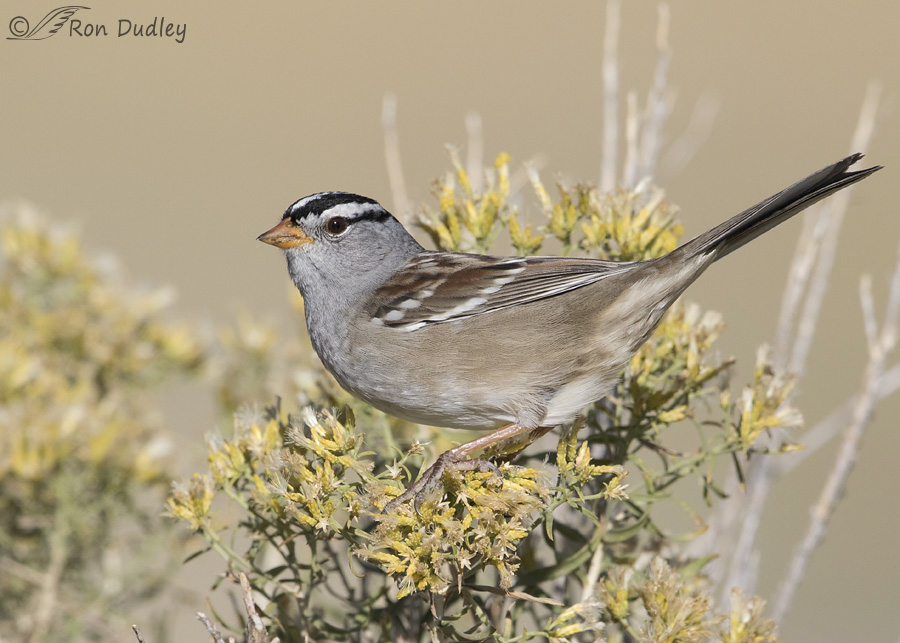 1/4000, f/7.1, ISO 640, Canon 7D Mark II, Canon EF 500mm f/4L IS II USM + EF 1.4 III Extender, not baited, set up or called in
1/4000, f/7.1, ISO 640, Canon 7D Mark II, Canon EF 500mm f/4L IS II USM + EF 1.4 III Extender, not baited, set up or called in
I found this one yesterday morning as it was feeding on rabbitbrush seeds on Antelope Island. It was literally gorging itself – this is one of the few images (out of hundreds) I have of the bird that didn’t have rabbitbrush seeds in or on its bill.
- I think rabbitbrush gets a bad rap. Many folks are allergic to its pollen and others don’t like its smell when the leaves or flowers are crushed (its species name “nauseosa” is evidence of that fact). But it provides cover for many bird species and others use it as an important food source. And it’s very attractive, especially when it blooms in the fall.
Ok, back to my sparrow.
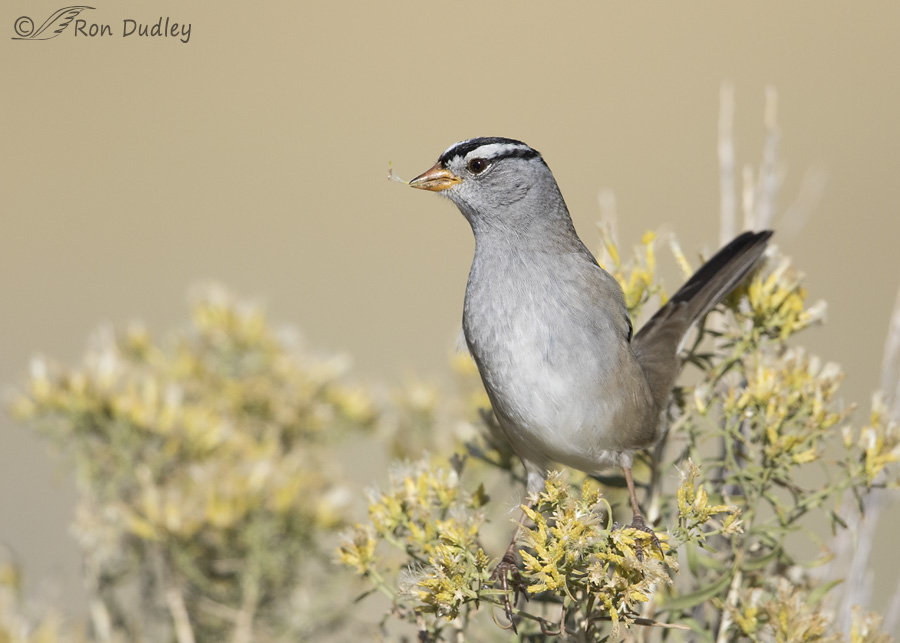
1/5000, f/8, ISO 640, Canon 7D Mark II, Canon EF 500mm f/4L IS II USM + EF 1.4 III Extender, not baited, set up or called in
I like this alert pose as the bird scans for another place to forage while it still has a single seed sticking out of its bill. Gluttony personified…
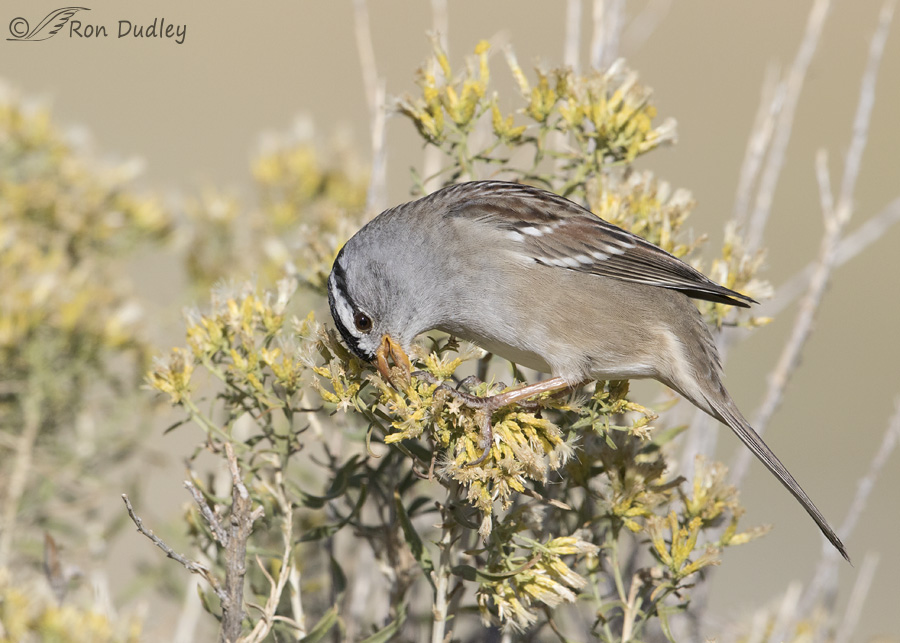
1/4000, f/7.1, ISO 640, Canon 7D Mark II, Canon EF 500mm f/4L IS II USM + EF 1.4 III Extender, not baited, set up or called in
The sparrow worked hard at gathering seeds – in fact I’d say…
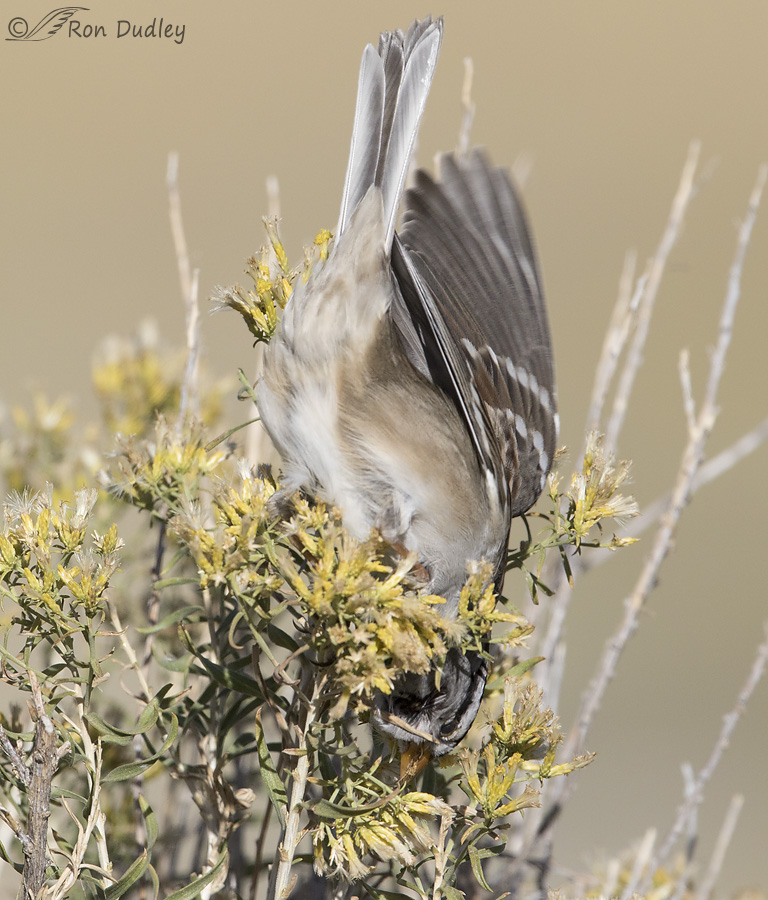
1/3200, f/8, ISO 640, Canon 7D Mark II, Canon EF 500mm f/4L IS II USM + EF 1.4 III Extender, not baited, set up or called in
it worked very hard. Its contortions as it tried to reach inaccessible seeds were impressive.
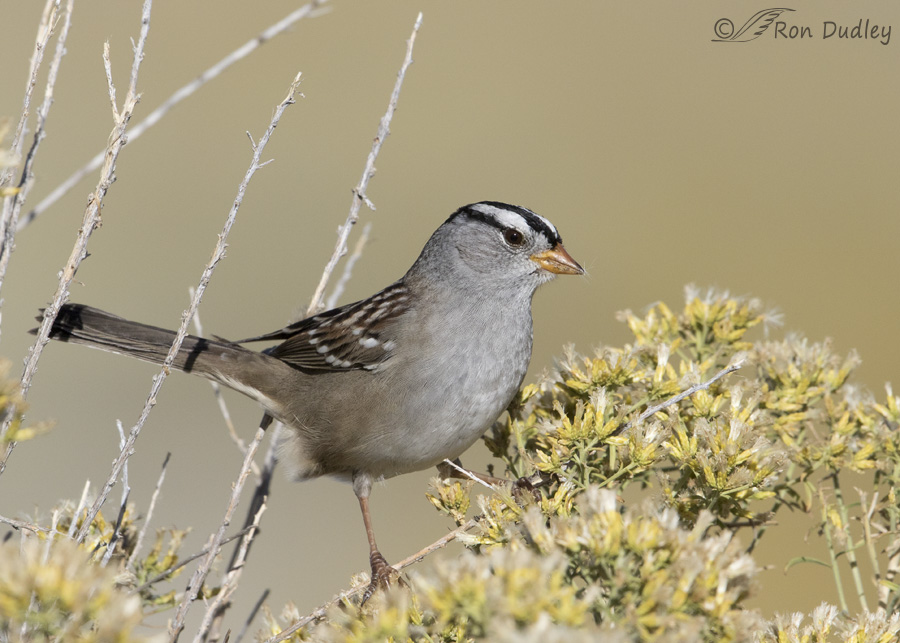
1/4000, f/8, ISO 640, Canon 7D Mark II, Canon EF 500mm f/4L IS II USM + EF 1.4 III Extender, not baited, set up or called in
A few seconds later it had moved on to another spot on the bush and here it’s inspecting the larder before…
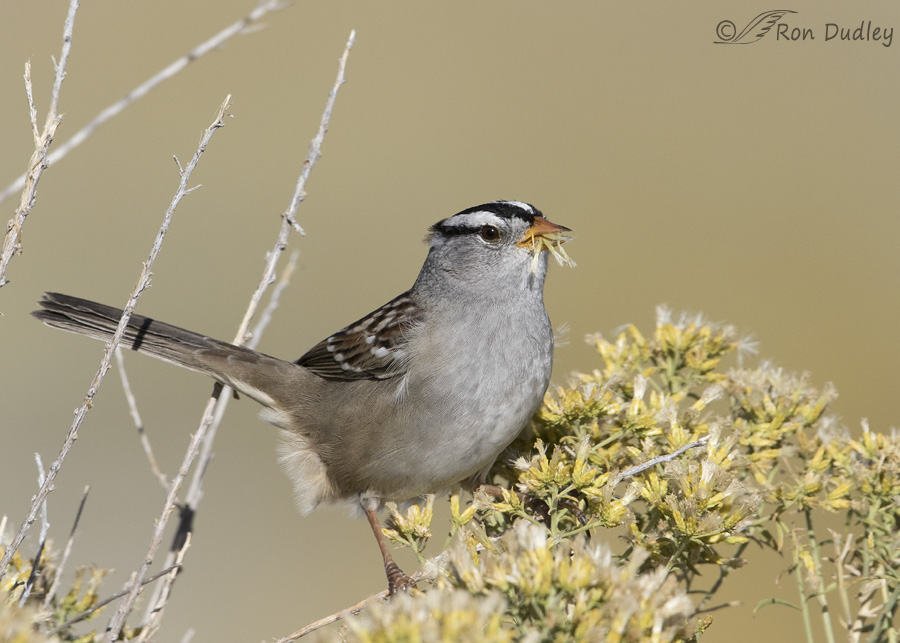
1/4000, f/8, ISO 640, Canon 7D Mark II, Canon EF 500mm f/4L IS II USM + EF 1.4 III Extender, not baited, set up or called in
gobbling down the groceries in great gulps.
There are two primary definitions for “common”. One is “abundant or prevalent” while the other is “showing a lack of taste and refinement; vulgar or coarse”. Some folks avoid referring to birds as common because of the demeaning implications of the second definition. I’ll continue to apply the word to birds and assume readers will know I’m referring to the first meaning.
This blog post has me thinking about other common species that are seldom the subjects of my posts. Perhaps it’s about time for me to feature the American Coot again. It’s been a while…
Ron


This is my favorite Sparrow. Unfortunately they are not in our area year round. They did come early this year. That put a smile on my face. I love their song, and they are very photogenic. Thank you for posting the pics.
I’m glad you enjoyed them, Jean. Thank you.
Ron. They are one of my favorite backyard birds. Thanks. They are worthy of your skill. Diana
And thanks to Culley for loving them along with RTHAs
You’re lucky, Diana. I’ve never seen one in my yard. I have to travel some distance to see them.
Diana, I’m SO easy when it comes to birds and critters 🙂 They’re the joy of my life. When I need peace, serenity, joy, laughter, or any other good thing like sanity, I count on birds and critters, and darn if they don’t share it in abundance.
Ron, nice images, and great to see “common” birds once in a while. I really like a number of the more common species. It doesn’t seem to matter how many times I photograph them, I’m always up for more. I like both the white-crowned and white-throated sparrows. I find their coloration very distinctive, making them great subjects. Red-winged blackbirds are another species I love watching and photographing. I look forward to seeing your American Coot photos (love their red eyes). I recall one very foggy morning along the Virginia side of the Potomac river just above Great Falls. I saw a dark shadowy figure swimming upstream towards me. It was so foggy I really couldn’t make it out, just that it was about the size of a duck and slowly coming my way. Eventually it got close enough I could identify it as an American Coot. It came up along the shore right in front of me, swam in place for a bit, looked at me, then moved back out into the river and further upstream. Seemed just as curious about me as I was of it. I love those types of moments.
Interesting story about your coot, Todd. I think we all have our favorite common species – one of mine is the little Pied-billed Grebe.
Love seeing your lbj’s.
Common and just are two words which do my head in as descriptions. Too many people use the terms as definitions instead. And miss the beauty.
Thank you, EC.
Love the White-crowned LBB’s. They are so clean and sharp looking compared to some. I would like to see more on the LBB’s since most don’t really “see” them. The can be tricky to capture since they move very quickly and don’t sit around as much as larger birds. Linda
“they move very quickly and don’t sit around as much as larger birds”
You’ve got that right, Linda. This bird and a few others were like little dynamos flitting around that rabbitbrush.
And I hate to make requests but being downtown city bound these days, I’d love to see a really good Ron Dudley picture of the “common” invasive European Starling. I miss seeing what Terry and I used to called “the hood” or that gang of starlings which would invade the lawns in our neighborhood. I loved their glossy dark speckled feathers and their gang antics. So don’t ever hold back on photographing common species by me. The old familiars are dear to my heart. I even miss the Robin who relentlessly sang on the neighbors antennae for a mate each spring, holding that large dried out worm in its beak as a prenuptial gift.
Glad you have fond memories of the neighborhood, Brenda.
I agree with you about robins, less so about starlings. Starlings can be so thick on my lawn and in my big elm tree that I can almost not see grass or branches. And their cacophony drives me nuts when they’re in those numbers.
I’ll admit though, their plumage colors in winter can be spectacular with good light on the bird. Maybe one day I’ll post a starling. But then again, maybe not…
We call the “the Mafia” partly because of their shiny, silk suits and theiit mob mrntslity….
That’s supposed to be “their mob mentality” …thank you, Evil iPad for “editing” my intended words….
When I hear the word “common” applied to birds, I cringe a little, hoping they remain that way. I think of how human activities are negatively effecting so many “common” birds and other once “common” crtitters, places and things…I remember that the Passenger pigeon was once common, too– that I never got to see one, and never will….
Agreed, Patty. I often think of “common” as a badge of honor.
That might seem a little strange to those who know my ancestry because many of my Dudley ancestors come from English nobility. During the Tudor years two Dudley’s lost their heads at the Tower of London so the distinctions of nobility and elitism can have their downsides… 🙂
Patty, I cringe in my soul, too. The other thing that makes me see red is when someone says, “…just a redtail.” In falconry, redtails are often seen as a beginner bird, one that you move away from to a “real” bird like a goshawk/peregrine/whatever. Those of us who have taken the time to really know our redtails know what a spectacular bird they are when the falconer comes up to the plate and works WITH them instead of against them 🙂 But that “…just a (insert plentiful species here)” always makes me cringe. In my head, I say, “Boy, you’re just not GETTING it, are you?” 🙂
I think of the Redtsil as the little brother of the eagle Golden eagle…
Wonderful series Ron!
charlotte
Thank you, Charlotte.
I love this series! I’m always happy to see what Ellie Baby calls “LBJ’s” and look forward to seeing the White-crowned and White-throated sparrows especially in the late fall and through the winter. They’re such cute, curvy little birds and relatively “tame” as they hop around looking for seed-spill under our feeders. The third shot reminds me of a traditional dancer Lakota friend we called”Feather Butt”. This is also a good reminder of the value of letting your faded flowers stand, rather than be cut diwn and discarded, so birds can enjoy the seeds (our town Code Enforcement Officer gives me grief for this-I do it anyway)..,
You make a good point, Patty. Some of our rabbitbrush has already gone to seed with the flowers fading while others are still bright yellow and vibrant. The birds prefer to perch on the ones that have gone to seed, for obvious reasons.
Patty, if you are interested I can send you the Eight Reasons NOT to Clean Up in the Garden printed by Prairie Nursery.
Maybe you could print it and give it as a present to the Code Enforcement Officer.
Thanks, Dick. I would LOVE IT!!! Will make copies and make sure our mayor, trustees and others get copies, too. Do you need my mailing address? Or are you thinking of an email? Ron, the Code Enforcement guy, hasn’t been around since I offered to cut him off at the ankles with the upside down putter I sometimes use instead of my frog cane…
Send me your e-mail and I will send it to you as an attachment. raharlow@comcast.net
The problem with some common species – House Sparrow comes to mind for me – is that you start to take a picture because it looks like an “interesting” bird and then you find out that it is “just” a House Sparrow. Even though all I take are snapshots, I think I prefer to capture more unusual birds with my camera. I’m thinking that maybe going for the more unusual (or sexier) is part of the human condition? I like this White-crowned Sparrow and I’d enjoy seeing a Coot again, too, especially if its feet are visible. To me, their feet are simply amazing.
Susan, hopefully I’ll be able to post some coot images soon. I love their feet too.
Yep, another Oh WOW (insert superlatives here)! What a spectacular series of images. White-crowned sparrows are near the top of my list of favorite birds. While living in Texas (both Dallas and Fort Worth) they’d regularly delight my soul with their outrageously beautiful song–so beautiful that it could break your heart with its clear loveliness. It always filled me with a joyous happiness. They’re right up there with chickadees and canyon wrens, among others.
Now for that pesky word/concept, “common.” While you mentioned the official definition, there are other underlying ideas that go with that word and none of them are any good when describing raptors, birds or any other critter for that matter. Mariah, my redtail hawk (who is no more “mine” than the air I breathe), explained that’s not a word that should be applied to living creatures. Words like abundant or plentiful are much better descriptors without the baggage that comes with that other word. Inherent in the word “common” when applied to birds/critters is a subtle disdain in the context of a common bird is just not that important or exciting–not worthy of any serious attention or study because they’re a dime a dozen. See one and there’s another five feet away. No problem. They’re everywhere. I cringe inside every time I hear it. And while the word common is an excellent word to use for politicians or other thieves/criminals, 😉 it simply doesn’t fit with these magical, wondrous, and just outrageously splendid birds.
Stepping off my soap box now. You are now free to roam around the planet.
Thanks, Laura.
Looks like you and I will just have to agree to disagree about the word “common” when applied to birds. For me (and apparently for many others who love birds including authors of field guides and other respected avian resources) the word in this context has no negative connotations.
That’s ok – we don’t have to agree on everything…
I think they are beautiful!! And so are your pictures! !!! Oh and coots ! Love em!! Especially their feet!
Thank you, Marina.
Well, just in my mind, the King of Sparrows is both the White-crowned and Fox Sparrow. But, they are not common here in Vermont until migration. However, you have some neat western sparrows, but here in Vermont we only see the White-crowned and Fox Sparrows, if we are lucky, in the Spring and Fall. However, usually in the fall we see only immatures White-crowned, which just came through 2 days ago. In the spring they are as good looking as the one you posted.
Love your shots, excellent series, love your behavioral shots!!
Dick, I see White-crowned mostly during migration too. And like you, most of them are immatures. One of the reasons I enjoy photographing them is because of the striking difference between adults and young birds. It’s almost like getting a twofer…
Do you have any shots of the immatures? I think many people would confuse the immature for another species other then White-crowned. When some people think of White-crowned, their thoughts in their mind, is of the male in breeding plumage.
Good idea, Dick. Here’s links to a couple of posts that feature photos of both adult and immature birds.
https://www.featheredphotography.com/blog/2015/11/27/white-crowned-sparrows-juvenile-and-adult-some-in-the-snow/
https://www.featheredphotography.com/blog/2015/01/02/white-crowned-sparrow-immatures-and-adults-skewed-populations/
Wonderful series, Ron. 🙂 Always seems to be the case that if there are many of something most of the time they tend to be ignored! 🙂 The American Coot is not exactly “charming” in many circles as you obviously know! 🙂 I’m look forward to some photo’s of them. 🙂
Judy, actually I’m fascinated by coot behaviors in springtime. Their pugnaciousness and breeding behaviors make them very interesting to watch and photograph.
And those amazing feet! I love coots, and sparrows too. They are one of the only birds that stick around all winter in the city, here in Wisconsin, and I appreciate that!
Agreed, Doreen – coot feet are attention getters, for sure.